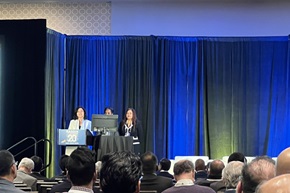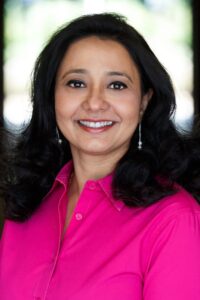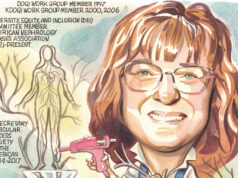 At this year’s American Society of Diagnostic and Interventional Nephrology (ASDIN) annual scientific meeting (23–25 February 2024, New Orleans, USA), outgoing president Vandana Dua Niyyar (Emory University, Atlanta, USA) used her president’s address to explore what the future looks like for ASDIN and the Society’s plan for action.
At this year’s American Society of Diagnostic and Interventional Nephrology (ASDIN) annual scientific meeting (23–25 February 2024, New Orleans, USA), outgoing president Vandana Dua Niyyar (Emory University, Atlanta, USA) used her president’s address to explore what the future looks like for ASDIN and the Society’s plan for action.
The leadership of ASDIN has been working hard, according to Niyyar, and focusing on their mission “to promote excellence in dialysis access care to improve outcomes for patients with kidney disease.” She averred that the leadership convened an in-person strategic planning retreat to review the current state of the organisation, identify opportunities for growth and capitalise on their strengths while acknowledging and addressing strategies to mitigate their weaknesses. “Our goal was, for this coming year, to identify and prioritise three to five mission-critical objectives, assign champions, give them measurable outcomes and provide them with the resources to succeed in achieving these targets.,” she stated. These objectives were as follows:
- To ensure that the patient perspective is incorporated into every aspect of ASDIN’s strategy and plan.
- To focus on the individual needs and provide personalized attention to each individual category of ASDIN membership including nephrologists, interventional nephrologists, interventional radiologists, vascular surgeons, dialysis nurses, dialysis technicians, and administrators.
- To work with ADSIN’s associates to develop educational curricula with didactic and hands-on workshops for nephrology technicians and nephrology nurses, with the ultimate goal of ensuring that every dialysis unit can have ASDIN-certified expert cannulators.
- To engage with the leadership of large dialysis organisations and explore value propositions for both sides.
Once the ASDIN leadership had these goals in mind, Niyyar stated, they then “went out and did the work of ASDIN”, which she summarised in two words as collaboration and individualisation.
One thing that Niyyar ensured was highlighted early during her address was ASDIN’s work towards improving certification, in particular the work of the haemodialysis vascular access certification (HVAC) committee and the endovascular arteriovenous fistula (endoAVF) committee. “The [HVAC] committee,” she averred, “is continuing its work supporting new certification programmes, streamlining the review process so it’s faster and more efficient and continuing timely processes of the multitude of applications that we receive”. Continuing, she added that “we founded the [endoAVF] committee last year, and we have certified 10 individuals so far. But as I keep emphasising, it is a living document, and as we get to version 2.0 and hopefully further, we’ll make sure that we maintain stringent quality criteria and make changes to our certification process as we evolve”. Niyyar also highlighted ASDIN’s work in improving training for both peritoneal dialysis (PD) and ultrasound. She shared that the PD committee had been focusing on identifying current training programmes and promoting more PD insertion training that would also help increase the number of patients dialysing at home, especially in light of the US Health and Human Services (HHS) initiative. Niyyar emphasised the increasing role of the USA in nephrology and highlighted the continued work of the ultrasound committee in certification in three key “nephro-centric” areas – kidneys, dialysis access and volume assessment, as well as the online library of training modules created by members of the ultrasound committee, and webinars in collaboration with International Society of Nephrology.

The outgoing president also highlighted the importance of continuing the creation and dissemination of new knowledge. The Society’s research committee had, according to Niyyar, “completely revamped the way we look at research,” stating that they “are now awarding annual US$25,000 grants for research”. The education committee had also been very active, she said, engaging with general nephrologists through the American Society of Nephrology (ASN), medicine residents through the American College of Physicians (ACP), and “reviewing multiple requests for endorsements for educational materials and meetings”.
One question that ASDIN was attempting to address was where trainees could find the necessary training that they need. “The training and workforce committee sent out an electronic survey to all ASDIN members,” said Niyyar. Based on the responses received, she stated that they “then created a comprehensive list that’s now available on the ASDIN website, where you can get information about the centre, the number of procedures performed, the kind of procedures that are performed and—since a lot of the nephrologists are IMGs [international medical graduates]—we have information about the visa requirements, as well as the opportunities for jobs after training”.
Another key aspect of continuing to grow, according to Niyyar, is engaging the next generation of interventional nephrologists. She lauded the fact that ASDIN had 20 travel grants last year, thanks to industry sponsors, and that this year, ASDIN is “proud to say” that they had self-funded 20 travel grants to support fellows. Another key facet of ASDIN’s attempt to engage with new generations was the social media committee; Niyyar stated that they had “been working with the renal fellow network” on their interventional nephrology series—which are now available online—and had also collaborated with medical journals to create visual abstracts for easy dissemination to everyone with interest in interventional nephrology. “Our surgical partners have also been very active,” added Niyyar, “promoting a comprehensive holistic approach, making sure that we incorporate the surgical perspectives and engage the younger residents, not just from vascular surgery, but general surgery as well”.
One final point that the president wanted to address was the participation of ASDIN members. “When you look at all the work that is being done [by ASDIN], you would assume that the majority of the membership is actively involved. I was curious about this question, and when I looked at the data, I could see that only 25% of our members are involved”. She continued, asking: “If we can see how much work is being done by just 25% of ASDIN members, how about if every single one of our members was actively involved?” Drawing the 2024 presidential address to a close, she ended by entreating the members of ASDIN to become more involved in the societies’ activities. “I really would request everyone to make sure that, if you can, please participate, because you can never underestimate the power of one. One voice can make a difference. If you are at all doubtful, I share this quote from Margaret Mead that I got from my mentor Prabir Roy-Chaudhury (University of North Carolina, Chapel Hill, USA); ‘Never doubt that a small group of thoughtful, committed citizens can change the world. Indeed, is the only thing that ever has.’ ASDIN has precedence in this area too. We have literally—both ASDIN and the field of interventional nephrology—revolutionised the way we do dialysis access in this country. Not only has ASDIN broken the glass ceiling, it has shattered it”.












